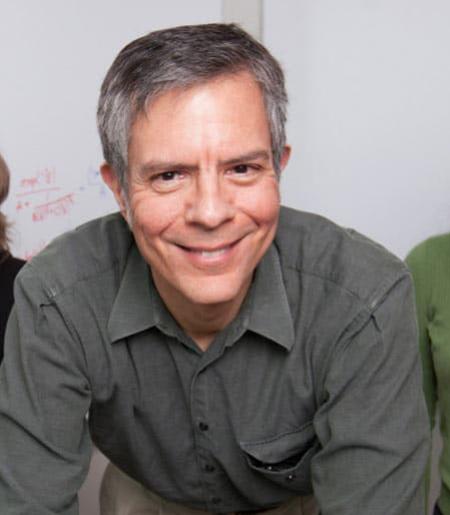Overview
Materials science, including crackling noise and avalanches in magnetic systems, tweed in shape-memory alloys, accelerated simulations of surface growth; glasses, including metallic glasses, low temperature glasses, slow relaxation, and scaling theories of the glass transition; disordered systems, including Griffiths phase in spin glasses, spin glasses on the Bethe lattice, sliding charge-density waves; liquid crystals; Blue Phases as networks of defect lines and in curved space; boojums in chiral smectic films; quantum instanton methods for atomic tunneling; early Berry's phase work in high-temperature superconductors; atomic tunneling from an STM/AFM tip; theory of vortex core states in superconductors; dynamical systems, including transition to chaos from quasiperiodic motion using renormalization group; noise in crumpling paper; dynamics of cell membranes and twisted DNA.
Research Focus
We've recently been using differential geometry tools to study how multiparameter models in many fields of physics (from systems biology to cosmology) have collective behavior which depends only loosely on their parameters. These "sloppy models" work for the same reasons that underlie continuum limits and the renormalization group. We have a new approach to understanding rigidity transitions, which have recently been applied to glasses, granular materials, foams, and biological tissues. And we are developing nonlinear renomalization-group methods for understanding the properties of systems near and far from continuous phase transitions.
Graduate Students
Stephen Thornton
Awards and Honors
- Sloan Research Fellow, 1985
- Presidential Young Investigator Award, 1985
Professional Experience
- Postdoctoral research associate, Cornell University, 1981-84.
- Postdoctoral research associate, Institute for Theoretical Physics, University of California at Santa Barbara, 1981-84.
- Assistant Professor, Physics, Cornell University, 1984-89.
- Associate Professor, Physics, Cornell University, 1989-95.
- Professor, Physics, Cornell University, 1995-present.
Publications
Visualizing probabilistic models with Intensive Principal Component Analysis, Katherine N. Quinn, Colin B. Clement, Francesco De Bernardis, Michael D. Niemack, and James P. Sethna, Proceedings of the National Academy of Sciences 116, 13762-13767 (2019). See also Data visualization could reveal nature of the universe (Cornell Chronicle article by Melanie Lefkowitz), and Algorithm to map universe, solve mysteries: Study(Times of India, June 26, 2019).
Chebyshev approximation and the global geometry of sloppy models , Katherine N. Quinn, Heather Wilber, Alex Townsend, and James P. Sethna Phys. Rev. Lett 122, 158302 (2019)
Cluster representations and the Wolff algorithm in arbitrary external fields, Jaron Kent-Dobias and James P Sethna, Phys. Rev. E 98, 063306 (2018).
Normal form for renormalization groups, Archishman Raju, Colin B. Clement, Lorien X. Hayden, Jaron P. Kent-Dobias, Danilo B. Liarte, D. Zeb Rocklin and James P. Sethna, Phys. Rev. X 9, 021014 (2019).
Deformation of crystals: Connections with statistical physics, James P. Sethna, Matthew K. Bierbaum, Karin A. Dahmen, Carl P. Goodrich, Julia R. Greer, Lorien X. Hayden, Jaron P. Kent-Dobias, Edward D. Lee, Danilo B. Liarte, Xiaoyue Ni, Katherine N. Quinn, Arichishman Raju, D. Zeb Rocklin, Ashivni Shekhawat, Stefano Zapperi, Annual Review of Materials Research 47 217-246 (2017).
Canonical sectors and evolution of firms in the US Stock markets, Lorien X. Hayden, Ricky Chachra, Alexander A. Alemi, Paul H. Ginsparg, and James P. Sethna, Quantitative Finance, 1-16 (2018). See also our stock analysis website.
Weirdest martensite: Smectic liquid crystal microstructure and Weyl-Poincaré invariance, Danilo B. Liarte, Matthew Bierbaum, Ricardo A. Mosna, Randall D. Kamien, and James P. Sethna, Phys. Rev. Lett. 116, 147802 (2016), pdf. (Cover story and Editor's Choice for PRL, Cornell chronicle story, and "Two different crystals can be described by the same mathematical rules", by Lisa Zyga at Phys.org.)
You Can Run, You Can Hide: The Epidemiology and Statistical Mechanics of Zombies, Alexander A. Alemi, Matthew Bierbaum, Christopher R. Myers, and James P. Sethna Phys. Rev. E 92, 022146 (2015). Much national media coverage (over 75 articles in the first week, starting with Popular Science, New Scientist, and the Washington Post; over half a million hits on both the Zombie simulator and the photo views.)
Sloppiness and Emergent Theories in Physics, Biology, and Beyond, Mark K. Transtrum, Benjamin B. Machta, Kevin S. Brown, Bryan C. Daniels, Christopher R. Myers, and James P. Sethna, J. Chem. Phys. 143, 010901 (2015).
Parameter Space Compression Underlies Emergent Theories and Predictive Models, Benjamin B. Machta, Ricky Chachra, Mark K. Transtrum, James P. Sethna, Science 342, 604-607 (2013); pdf, full text. See also Physicists unify the structure of scientific theories in the Cornell Chronicle (Anne Ju) and Kathryn McGill's vblog Soft Matters with Jim Sethna from The Physics Factor.
Collective motion of humans in mosh and circle pits at heavy metal concerts, Jesse L. Silverberg, Matthew Bierbaum, James P. Sethna, and Itai Cohen, Phys. Rev. Lett. 110, 228701 (2013). See Jesse Silverberg's TED talk. Extensive press coverage (Atlantic, Physics World, Popular Science, New Scientist, NBC, National Geographic ...); full listing at Silverberg's Mosh-pit page
In the news
- Replica theory shows deep neural networks think alike
- Spring 2024 Bethe Lecture bridges physics and computer science
- Hummingbird beak points the way to future micro machine design
- Three faculty elected fellows of American Physical Society
- New Frontier Grants push boundaries in A&S research
- Ten A&S faculty honored with endowed professorships
- Next-gen particle accelerator is aim of Bright Beams work
- Microscope becomes gauge to measure forces within crystals
